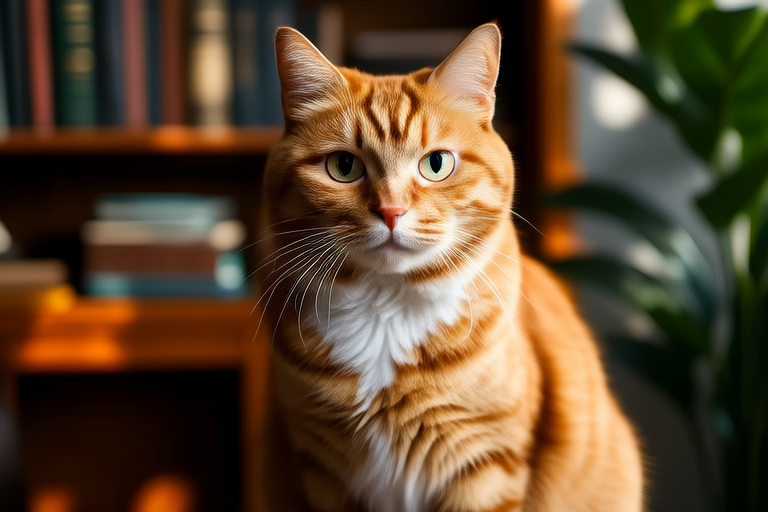
The Enchanting World of Orange Cats: Personalities, Traits, and Bonds
Orange cats have long been admired for their striking appearance and unique personalities. From ancient folklore to modern-day households, these felines have captured the hearts of many with their vibrant coats and intriguing behaviors. This article explores the distinct personalities of orange cats through personal anecdotes, scientific insights, and cultural references. We will discuss common traits such as friendliness and curiosity while highlighting individual quirks. Interviews and observations from cat owners and experts will provide engaging stories that illustrate the unique characteristics that make each orange cat special.
Friendliness and Curiosity: Common Traits of Orange Cats
One of the most notable traits of orange cats is their friendly nature. Many owners report that their orange felines are sociable and enjoy spending time with both humans and other animals. “My orange cat, Whiskers, is always eager to greet me when I come home,” says Sarah, a proud owner of a ginger tabby. “He follows me around the house, purring contentedly and seeking attention.” This affectionate behavior is often attributed to the breed’s history as companion animals.
Curiosity is another defining characteristic of orange cats. Their inquisitive nature leads them to explore new environments and investigate unfamiliar objects. Dr. Jane Smith, a veterinarian with over 20 years of experience, explains, “Orange cats tend to be more adventurous than other breeds, which can sometimes lead to mischief. However, this curiosity also makes them great problem-solvers and keeps them mentally stimulated.”
Individual Quirks: A Closer Look at Orange Cat Personalities
While orange cats share common traits, each one possesses unique quirks that set them apart. Some orange cats are known for their playful antics, while others prefer more serene activities. For instance, Tom, an orange cat owned by Mark, enjoys chasing laser pointers but becomes anxious during thunderstorms. In contrast, Lucy, another orange cat owned by Emily, prefers lounging in sunbeams and napping in cozy corners.
Experts suggest that these differences in behavior may be influenced by factors such as genetics, upbringing, and environmental factors. “Just like humans, cats have individual personalities shaped by their experiences,” says Dr. Smith. “Understanding your orange cat’s preferences can help you create a comfortable environment that meets their needs.”
Cultural References and Historical Significance
Orange cats have appeared in various cultural references throughout history. In ancient Egypt, cats were revered as sacred animals, and some depictions featured orange felines. Similarly, in Japanese folklore, Maneki Neko, the famous beckoning cat, is often depicted as an orange tabby. These references highlight the significance of orange cats in different cultures and their enduring appeal.
In modern times, orange cats continue to inspire artists, writers, and filmmakers. For example, Garfield, the beloved comic strip character created by Jim Davis, is an orange cat known for his sarcastic wit and love of lasagna. While Garfield is a fictional character, he embodies the playful and curious nature of many orange cats.
The Bond Between Humans and Their Feline Companions
The relationship between humans and their orange cats is often described as special and enriching. “Having an orange cat has brought so much joy into my life,” shares Sarah, the owner of Whiskers. “He has a way of making me feel better when I’m feeling down, and his playful antics always bring a smile to my face.”
Experts agree that the bond between humans and their feline companions can have numerous benefits. “Studies have shown that petting a cat can lower blood pressure and reduce stress levels,” says Dr. Smith. “The unconditional love and companionship provided by an orange cat can improve overall well-being.”
Avoiding Stereotypes and Delving into Nuances
It’s important to avoid generalizing the behavior of orange cats and instead appreciate the nuances in their personalities. While some may be friendly and outgoing, others might be more reserved or shy. Understanding and respecting these individual differences can help strengthen the bond between humans and their feline companions.
For example, Sarah, the owner of Whiskers, notes, “At first, I thought all orange cats were the same, but I’ve learned that Whiskers has his own unique personality. He’s not just a friendly cat; he’s my best friend who brings laughter and comfort into my life.”
Conclusion: Celebrating the Unique Characteristics of Orange Cats
The world of orange cats is rich with diversity and charm. From their friendly and curious nature to their individual quirks, these felines have much to offer their human companions. By exploring the distinct personalities of orange cats through personal anecdotes, scientific insights, and cultural references, we gain a deeper appreciation for their unique characteristics. As we celebrate the bond between humans and their feline companions, let us remember to cherish and respect the individuality of each orange cat.




